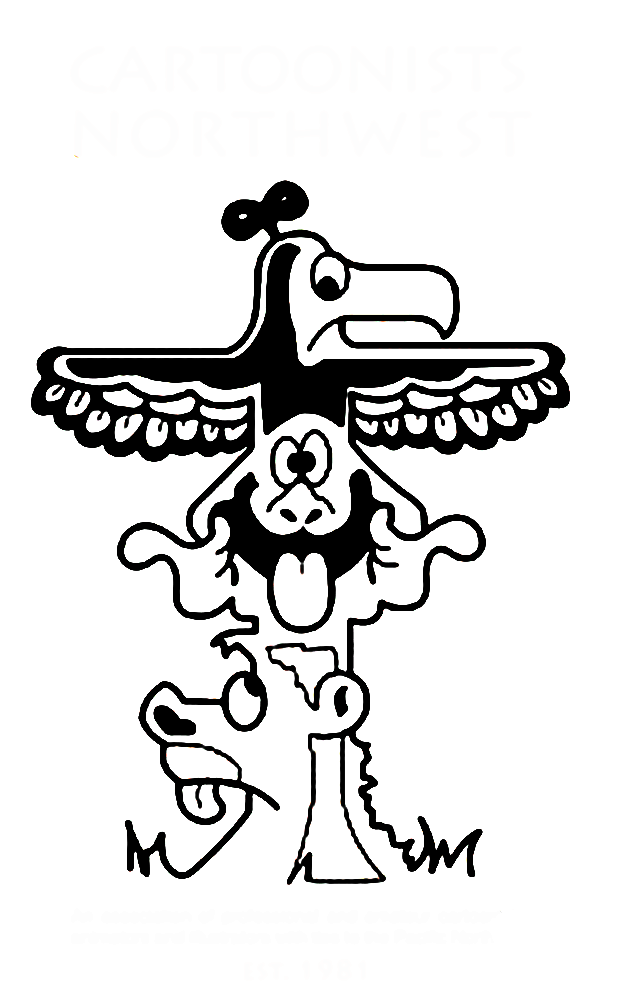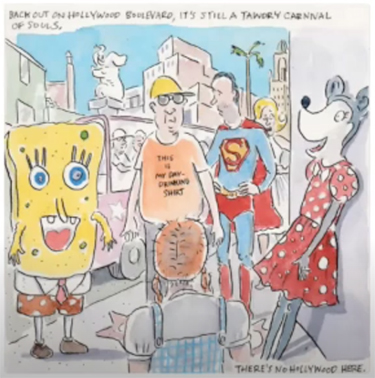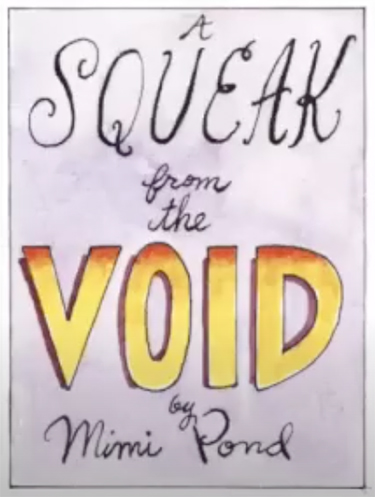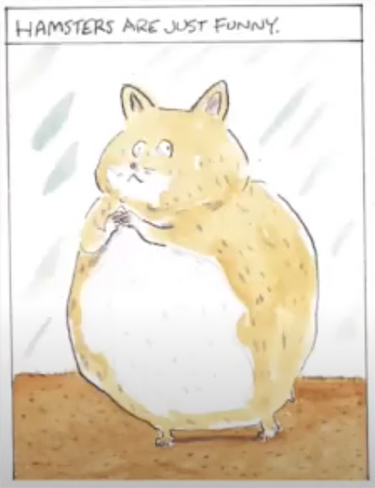Michael Jantze the long and short of it
February CNW meeting review
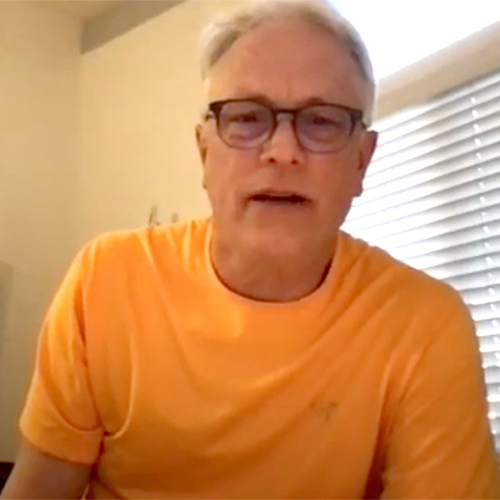
Michael Jantze was introduced by Cartoonists Northwest President Bill Morse as our Guest Speaker for February 2022.
“Should we start with the long version or the short version?”, Michael laughed.
“I’ve had a career that for some people raises an eyebrow at some point. But thehighlights have been: First, graduating from film school in Los Angeles and trying to work in animation in the mid-1980’s, and things didn’t go quite well. Just because things were falling apart, and jobs were scarce, and ended up working on a lot of documentary filmmaking, educational filmmaking. And at the same time keptdoodling comics while in college (as one does as a cartoonist).
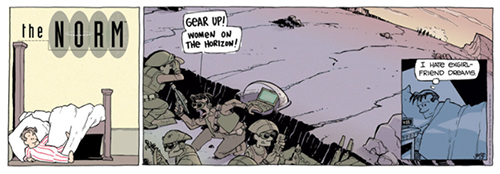
“And while I was working on going back to grad school, I started doodling a college strip for Cal State Northridge, which was Normal State. I turned that into Normal USA and started taking those characters and self-publishing a book. And that led to me not going to grad school because I suddenly realized how much I was enjoying writing stories as comics as much as I was enjoying working in film. Maybe I could achievesome of my goals through comics as much as through film.
“So that was sort of my first moment where I realized you turn that first corner creatively. What fifteen-year-old youth thought it wanted was a little wrong, but twenty-three-year-old youth knew that was still a good idea but could direct that a little into different activities.
“So instead of working on feature films and so forth, animated feature films and
live-action feature films and the like, I ended up writing my own comics.
“That led to a deal with DC Comics … kind of the strangest thing. I had put together this self-published book in bookstores around the Bay Area, Los Angeles and a couple of towns in the Mid-West where I’d lived. And out of the blue, one person called and left a thing on my answering machine and said he was a cartoon agent.Through that, we worked on some stuff and he thought he could take it to Piranha Press, which was owned by DC.
“And so they wanted to buy this Normal USA book. By then I had sent it to some syndicates as a submission for a daily strip. And I’d had a call back from a syndicate and got some nice responses. I was feeling, ‘Oh, I’m so close and I don’t want to
do this with DC’ so I sold them another idea and
worked on that for a few years.
“Then I got into journalism, because I didn’t need to live in LA, and went to work at the Times-Picayune newspaper in New Orleans, working with quite a few talented artists and becoming the Graphics Editor.
“Between the DC deal and that job, I was just worn out. And I wasn’t getting to the development of my Development Deal with United Media by that point. It was just awful, I felt lost. So I packed everything up, got out of management, and moved
back to California. I took a job at a smaller paper so I could focus on my strip at night.
“It was a big gamble, if you know what I mean. One of those choices in life; ‘If I’m going to do this, I better do it while I’m young’. And it panned out. One of the things I asked for when they hired me was to give me room on the comics page (this was before the internet) for a comic I wanted to draw. And it wasn’t Normal USA, I was going to come up with something else. So I took my journal that I’d been keeping, a graphic journal, and I started putting ideas together that, obviously, became The Norm.
“All of these things are named Norm for a reason; because I grew up in a town in Illinois called Normal. So that was the word that just stuck. I was surprised nobody had ever used “the norm” for anything.
So it was like, ‘that kind of made sense, this kind of a wacky guy who was not the norm and all that.
“So they ran that in the paper for about six months and I sent that package off to the syndicates and I got two syndicate offers! I had figured out that drawing a daily was going to solve and kind of finish finessing all of that stuff that had never worked before.
“You know; you’d send in some stuff, and then they’d give you some ideas, and
all of that. Just doing a daily for six days a week was what I needed to finish that up.
“Unbeknonst to me, one of the editors had gone into the hospital for surgery
and so she wasn’t returning my calls. So I went with King Features”, he recalled. “Years later, I found out what actually happened.
“King was excited about the strip and it launched in about forty papers. So I did the strip, had a fifteen year contract and an eight year break. I did the strip in syndication for eight years.
“Right behind me was ‘Zits’ and the sales stopped. And everything dried up. Sales did pick up slowly, we got up to about seventy-eight papers. Then we were over one hundred papers (total, counting ones that had quit). But I was stuck at this kind of middling salary and by then I’d also moved back to California, living in Marin County, and a neighbor asked me if I wanted to interview for a job. That was at Industrial Light & Magic where I ended up doing storyboards for a while for some commercials. At home, I was designing websites for New York Times newspaper group. After six months ILM called offering a full time job. So then I was working on feature films from Saving Private Ryan on for about five years.”
Much, much more interesting and entertaining conversation with Michael can be enjoyed by watching the recoring of our zoom meeting on our CNW Facebook page.
youtube.com
An Evening with Mimi is exactly what happened
January CNW meeting review – Mimi Pond began her presentation with some web comics she has done, before”ramping up and talking about (her) current projects”.”I started doing webcomics in about 2014. The first one I did, I just put on my own website. It’s really a strange story, called ‘A Squeak from the Void’, it just begged to be a cartoon.”
She entertained us by reading from her comic for a few minutes. In the story, Turner Classic Movies and its host Ben Mankowitz are featured, as is the annual TCM Film Festival. Mimi segued into attending the next years TCMFF, where she saw Peter Bogdanovich interviewed, went to a viewing of Robert Donat’s “The Magic Box” (1951).
“It’s fun becoming something of a journalist, collecting all of this information, and then trying to figure out what to do with it”, says Mimi.
She also attended an auction of Zsa Zsa Gabor items offered by her estate. “And I don’t know if you guys have had this happen to you, but sometimes as a Cartoonist you walk into situations and it just like someone has presented you with an enormous gift. A beautiful, beautiful, brightly wrapped, sparkly ribboned gift that just yours to open and play with as you want. And this was exactly what happened.
“I did this for the Los Angeles Times back in 2018. Long before there was Kardashians, there was Zsa Zsa Gabor. The auction preview of her estate was held at
her home in Bel Air.”
After watching “Sunset Boulevard”, Mimi found herself on Hollywood Blvd staring down at Zsa Zsa’s star. And then it was time for Mimi to take questions
David Lasky asked Mimi how, once she gets into the research, how she knows when to stop, to rein it in? And Mimi responded you take it all in and whittle it down, knowing there’s a lot more details and stories, but you just focus on the most critical parts.
Are you using inks or watercolors, she was asked. “I’m using this fantastic Daler Rowney Prussian blue acrylic ink and Higgins super white. It’s an acrylic ink, and it gives you a really wide variety of tones. Should have also mentioned I use mostly a Japanese Platinum fountain pen that has carbon black ink cartridges. There are a couple different nibs but I can’t recall which mine is. For the white I ink though I use some kind of crow quill dip pen. And those are uni-ball white signo gel pens both fine point and broad point for whiting out and highlights and textures. And arches 90lb cold press wc paper.”
“That was fun! Sorry I was out so abruptly, my dog wouldn’t stop barking (unusual for her) and I had to go see what was going on.
Of course it was nothing. She wanted me to let her downstairs to go hang out with my husband who couldn’t hear her. She’s 13 and getting eccentric. Usually also I’m at her beck and call. Anyway! Doing all that talking was helpful for me, I hope it was for everyone else!”
Watch the entire meeting for more with Mimi at:
mimipond.com
The Little Dragon that sold really, really well
October cnw meeting review
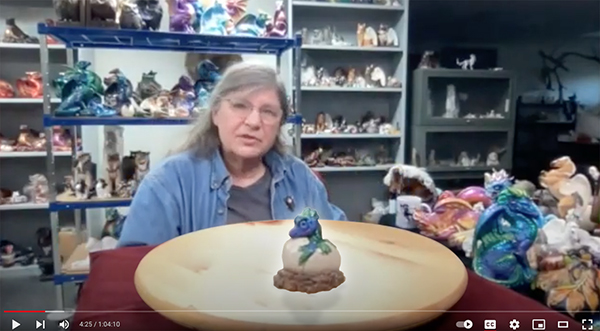
Melody Peña is a sculptor and a cartoonist whose career was launched by “astupid little contest in the bookstore of our college. “Her entry was some unicorn sketches which the person running the show liked and offered to buy on the spot. Instead she and her husband decided to print and sell them. The line of her art sold in the 1970s and 1980s at co-op craft stores along the West coast. “We sold tonsof them … and then they didn’t”, she recalled.
Thus in 1982 or ’84, Melody realized she needed to start a new business. A ceramist friend, Mark Hines, asked if she and her husband Mark wanted to join him in a sculpture business. Mark wanted to get away from the environmental issues with having to fire a kiln, and they settled on Gypsum which sets up chemically.
Next, it was up to Melody to come up with some dog figurine designs, as dogs were quite popular at that time. Instead, Melody went with fresh ideas (Lion, Cat, Bear, Armadillo) but they didn’t sell well to gift shops, only through wholesalers who then sold them all over the world.
“And then I did one little Dragon,” she recalled, “And that sold really, really well. And we’d been about ready to give up. So Mark said, ‘Why don’t you make a Mommy for it?’ and so I made the Mommy Dragon, and that sold incrediblywell.”
“I don’t consider myself an Artist,” Melody explained, “I consider was all about: what would sell in a store; what would look good on a retail store shelf. And then I made the Daddy Dragon, and these guys really took off. And we started a company. And we began to make all kinds of dragons and dinosaurs.
“I start with a sculpture, it can be made of any material (Scupley for example). I make a guy that’s pretty close to the final shape I want. The in gypsum, and this I carve-polish-sand very carefully and make it perfect. And then we cast them again and again and again until I get them perfect. And then we test paint. And from there we will make a production mold.”
“We’ve done Kickstarters. They’re really a lot of work. I did probably 300 ofthese and people could choose the one they wanted. They had to email me whichone they wanted and everybody wanted the same one. Finally I just had to duplicate the paint scheme everybody wanted. I made a lot of money on that Kickstarter.”
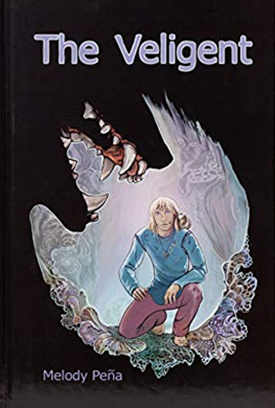
I do a comic, called the Veligent, and the animals in the comic are often the animals in the Winston line.
She doesn’t sell through gift stores so much anymore, not since 2008 when so many gift stores went out of business. Most of her figures are sold directly from her website: https://windstoneeditions.com and on eBay.
“They go for a lot of money on eBay”, she understated, then admitted “It’sastonishing sometimes.”
Further on in the presentation, Melody talked about and showed us Poads (fromthe Veligent) and Hippo-griffs, samples of her gag cartoons, and much more.
And, of course, you can watch the whole enjoyable zoom meeting with Melody Peña
Llyn Hunter
Cartoonists Northwest President Bill Morse introduced our guest speaker Llyn Hunter – storyboard artist, illustrator and cartoonist.
When Llyn was twelve she got her first professional job working for the Art Director for the Nice Public Library. She enjoyed working at the library so much that when she was 18 and the Art Director took the summer off, she filled in at that position. And she has been working, more or less, on and off, as a professional artist since then, in production and graphic design and art direction.
She was the Art Director for the Los Angeles Zoo for about a year and a half. Then AD for a small publishing firm called Frank Schaefer Publications that did educational materials.
“I did my stint trying to be a children’s’ illustrator for a while. I found that I was working 60-to 80-hour weeks, trying to make a living as a freelance illustrator. And while I was doing that I was taking classes at the Animation Union. If you live in Los Angeles, the Union offers classes in Life Drawing and Layout and Storyboarding and things like that. It was a great place to do Two-Minute Poses”,Llyn explained. The class was taught by a professional storyboard & layout artist name of Glenn Vilppu, and she decided she’d like to do that as it was a salaried position and she understood some Studios would hire out storyboard artists to advertising firms. You would be hired for the day to do storyboards and what-have-you. And she thought a salaried position beat working freelance, and she liked the idea of knowing where & when her next paycheck would be coming.
When she told her instructor she wanted to take storyboarding classes and get that type of job. He offered to hire her to work for him on the spot.
Llyn recalled, “There was a show called Peter Pan and the Pirates (1990). Glenn
was doing both layouts and storyboards and finding it overwhelming, and he gave me his storyboards to clean up. And that’s how I learned to storyboard.”
“At that time, I’d already made my money for that year. I’d busted butt as an illustrator, I’d already made my money to cover expenses so I could afford to drop down to $500 a week and do that work for him. Basically, that’s how I got to learn storyboarding and that’s how I got into the profession,” Llyn shared.
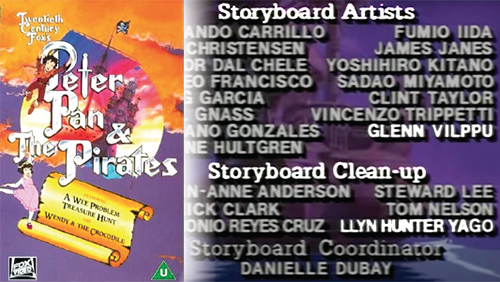
“The biggest problem when you’re storyboarding for television, versus film, is that you’re doing around 100 drawings a week minimum. It’s a lot of drawing. And it’s a very short turnaround, usually it’s five weeks to turn around a third of the script (around 13 to 15 pages). Basically you are constantly drawing and constantly running around with your shoes untied”, she shared. “I can remember doing 30 pages of roughs and 30 pages of cleanup a day. It was always trying to get 10 to 30 pages done every day. Three panels on a page. And that was on paper up until 2008. And what I find fascinating nowadays is there is an entire generation of people who have never worked on paper at all.”
“If you are interested in doing storyboarding or animation of any kind, I would highly recommend ToonBoom Storyboard Pro. Unfortunately it costs $65 a month. There are some good programs that are less expensive. But I’m required to at least have Toon Boom Storyboard Pro because if you’re going to do anything for the industry that’s what they require nowadays. ThankYouDisney.,”
Once I got into animation, thirty years of it, I went from working on Peter Pan and the Pirates, my very first show, to the Legend of Prince Valiant, which poor Hal Foster would be rolling in his grave if he knew what they did to Prince Valiant. Then I went to Disney, got into their Apprentice Program, and worked on Little Mermaid, Darkwing Duck, Raw Toonage, Quack Pack, Aladdin, Hercules, Buzz Lightyear. And
then I went over to Universal and worked on Beethoven and Woody Woodpecker. Went to Warner Brothers to work on Animaniacs, and Pinky & the Brain. At Sony I worked on Project Beeker. Worked on just about all ten seasons of Curious George. Scooby-Doo. Weird Al’s Soccer All-Stars.”
You can watch the entire meeting with Llyn at
Approximation Representation
properly portraying perspective
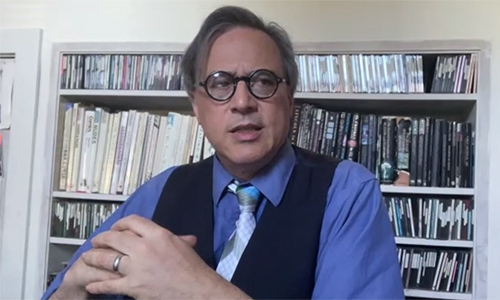
Cartoonists Northwest President Bill Morse introduced our August guest speaker David Chelsea.
“What I’m going to be presenting today is a Powerpoint Presentation that I created about ten the information in it is still good,” David explained, “perspective doesn’t change that much.”
First David showed an illustration of basic perspective principles, “Which I did not always understand perfectly,” he recalled.
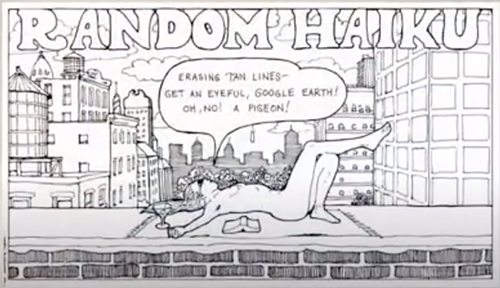
“A few years later, I went to art school, and lasted a full semester at School of Visual Arts. This included one session devoted to perspective. So, armed with that I was able to realize that all the lines go to a single vanishing point.” David said. “I quit art school in order to work as an illustrator, I had no respect for what they were teaching me. Possibly I should have stayed, listened more, taken more perspective courses … but this is the arrogance of youth.”
“I kind of muddled through as a freelance illustrator for a few years working at this level.” David recalled, “Until I got a job the at was more of a challenge. This was for an ESL textbook, meant to be kind of a film noir murder scene with two dead bodies on the floor. And I needed to draw a tile pattern on the floor and make it all realistic. I was kind of lost.
As it happens, my next door neighbor was a graphic designer. I asked ‘Do you have any books on perspective?” and she gave me Architectural Perspective by Frank Ching which was an excellent introduction. So I was able to do this sketch, and then the finished piece.”
“Then I saw an ad for a workshop in Linear Perspective by Gary Faigan. After the workshop I was able to do more ambitious things.”
“Now as much fun it is to set up perspective from scratch, sometimes under deadlines you want a little bit of a shortcut. (perspective grids for architects) worked fine for illustration, but had their limitations.”
“I eventually decided to create my own grids: Fish-Eye, Curvilinear. Working out the geometry myself, photocopying one little section to make the bigger diagram. So with that, I was able to do a better job of it.”
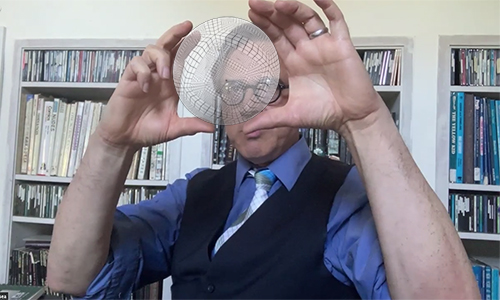
“In 1997 I had moved back to Portland, OR and I did my first perspective book. (Perspective! For C omic Book Artists) And there is a section in the back where I included some of my hand-drawn perspective grids. A year or two aft er that book came out, I got a computer, and that was a momentous step for me. One of the first things I did was get a CG program and create my own perspective grids.”
“And back then I had an unrealized project: a book of perspective grids including human figures. There already were books with this, but they all had blank backgrounds so you couldn’t see how this would fit into a perspective scene. You’d have to guess or estimate it. Having done that I was able to put her into one of my perspective grids.”
David ran a video of him drawing this Random Haiku strip based on a human figure and his perspective grid.
The meeting wrapped up with a Question & Answer session.
